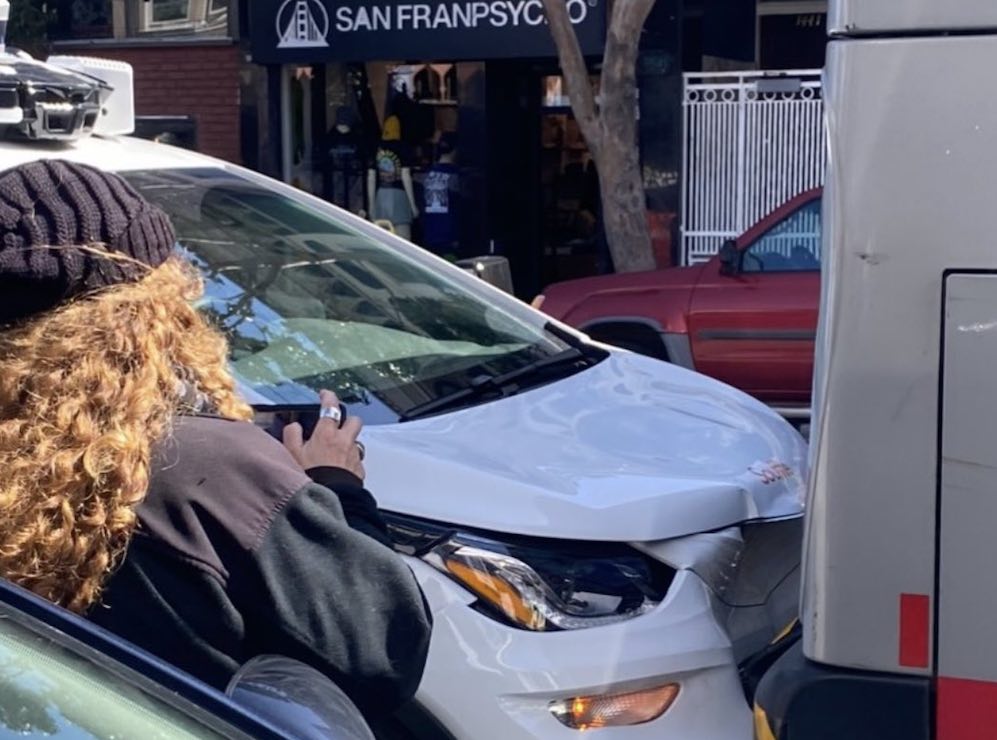|
Listen to this article  |

Last Thursday, March 23, 2023, a Cruise robotaxi, operating autonomously and with no driver or passengers in the vehicle, was involved in a minor accident with a San Francisco Muni bus. No one was injured in the incident. Both the Cruise vehicle and Muni bus received some damages, with the robotaxi seeming to take the brunt of the impact, according to Forbes.
While there aren’t many details about the accident, Cruise tweeted the following brief statement after the incident: “Yesterday, one of our vehicles made contact with the rear of a Muni bus. No injuries were reported, and there were no passengers present in the Cruise AV. We are investigating the incident and will take follow-up actions if appropriate.”
Robotaxi companies are typically quick to clear things up if their vehicles aren’t at fault in incidents. So many are assuming the Cruise robotaxi rear-ended the bus, based partly on Cruise saying in the statement one of its vehicles “made contact with the rear of a Muni bus.”
This afternoon, one of our vehicles made contact with the rear of a Muni bus. No injuries were reported, there were no passengers present in the Cruise AV, and it has been cleared from the scene.
— cruise (@Cruise) March 24, 2023
This incident happened just days after another Cruise robotaxi drove through caution tape that closed off a road where overhead trolley wires had fallen during a major high-wind storm. The vehicle hit the wires which were powered off at the time. Had the power lines been live when the vehicle hit them, the incident could have been much worse.
In December, the National Highway Traffic Safety Administration (NHTSA) announced it was opening an investigation into the company’s automated driving system. In a filing, NHSTA said it was interested in two different issues that had been reported to the administration that both result in the robotaxis becoming hazards for others on the road.
NHSTA’s first concern is with the company’s robotaxis reportedly braking too hard in certain circumstances. The administration received three reports of a Cruise vehicle braking too hard in response to a car approaching them quickly from the rear, resulting in the Cruise vehicle being rear-ended in all three incidents.
The administration’s second concern is with the robotaxis becoming immobilized on the road. NHSTA has received several reports of Cruise vehicles stalling on the road, with no human operators present. NHTSA’s Office of Defects Investigation (ODI) opened a preliminary investigation to determine the scope and severity of both issues.
Last week, Cruise filed an application with the California DMV to test its robotaxis statewide. The company has been working to expand its services in several areas, including in Austin and in the suburbs of Phoenix. It’s also working to roll out its purpose-built Origin vehicle on public roads in San Francisco.
Last month, Cruise announced its fully driverless vehicles have traveled over one million miles. A majority of Cruise’s fully driverless miles were driven in San Francisco, where the company first rolled out its robotaxis in November 2021.
The Robot Report reached out to Cruise for details on both incidents but hasn’t heard back as of press time. If we do get any more information, this story will be updated.
Credit: Source link


Comments are closed.